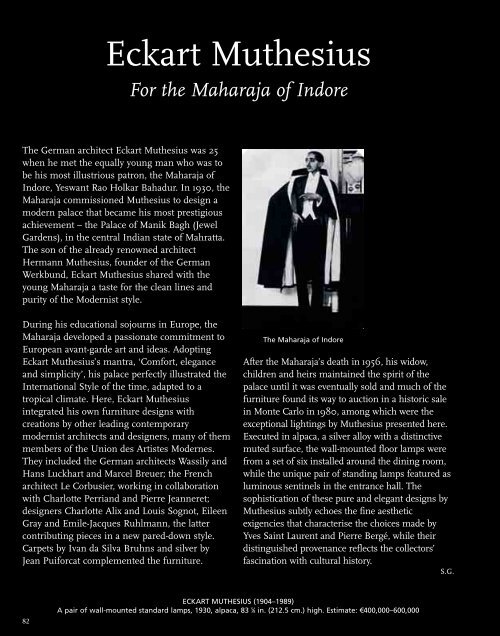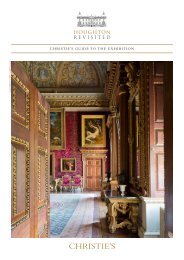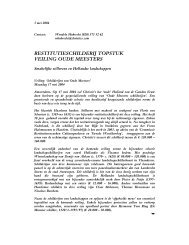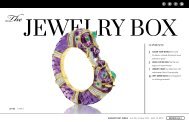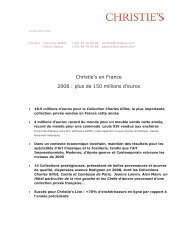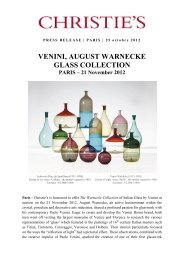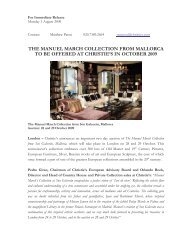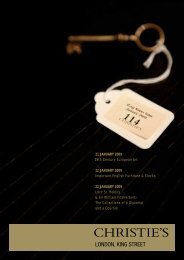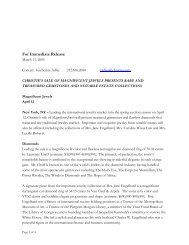Yves Saint Laurent Pierre Bergé - Christie's
Yves Saint Laurent Pierre Bergé - Christie's
Yves Saint Laurent Pierre Bergé - Christie's
Create successful ePaper yourself
Turn your PDF publications into a flip-book with our unique Google optimized e-Paper software.
The German architect Eckart Muthesius was 25<br />
when he met the equally young man who was to<br />
be his most illustrious patron, the Maharaja of<br />
Indore, Yeswant Rao Holkar Bahadur. In 1930, the<br />
Maharaja commissioned Muthesius to design a<br />
modern palace that became his most prestigious<br />
achievement – the Palace of Manik Bagh (Jewel<br />
Gardens), in the central Indian state of Mahratta.<br />
The son of the already renowned architect<br />
Hermann Muthesius, founder of the German<br />
Werkbund, Eckart Muthesius shared with the<br />
young Maharaja a taste for the clean lines and<br />
purity of the Modernist style.<br />
During his educational sojourns in Europe, the<br />
Maharaja developed a passionate commitment to<br />
European avant-garde art and ideas. Adopting<br />
Eckart Muthesius’s mantra, ‘Comfort, elegance<br />
and simplicity’, his palace perfectly illustrated the<br />
International Style of the time, adapted to a<br />
tropical climate. Here, Eckart Muthesius<br />
integrated his own furniture designs with<br />
creations by other leading contemporary<br />
modernist architects and designers, many of them<br />
members of the Union des Artistes Modernes.<br />
They included the German architects Wassily and<br />
Hans Luckhart and Marcel Breuer; the French<br />
architect Le Corbusier, working in collaboration<br />
with Charlotte Perriand and <strong>Pierre</strong> Jeanneret;<br />
designers Charlotte Alix and Louis Sognot, Eileen<br />
Gray and Emile-Jacques Ruhlmann, the latter<br />
contributing pieces in a new pared-down style.<br />
Carpets by Ivan da Silva Bruhns and silver by<br />
Jean Puiforcat complemented the furniture.<br />
82<br />
Eckart Muthesius<br />
For the Maharaja of Indore<br />
The Maharaja of Indore<br />
After the Maharaja’s death in 1956, his widow,<br />
children and heirs maintained the spirit of the<br />
palace until it was eventually sold and much of the<br />
furniture found its way to auction in a historic sale<br />
in Monte Carlo in 1980, among which were the<br />
exceptional lightings by Muthesius presented here.<br />
Executed in alpaca, a silver alloy with a distinctive<br />
muted surface, the wall-mounted floor lamps were<br />
from a set of six installed around the dining room,<br />
while the unique pair of standing lamps featured as<br />
luminous sentinels in the entrance hall. The<br />
sophistication of these pure and elegant designs by<br />
Muthesius subtly echoes the fine aesthetic<br />
exigencies that characterise the choices made by<br />
<strong>Yves</strong> <strong>Saint</strong> <strong>Laurent</strong> and <strong>Pierre</strong> <strong>Bergé</strong>, while their<br />
distinguished provenance reflects the collectors’<br />
fascination with cultural history.<br />
S.G.<br />
ECKART MUTHESIUS (1904–1989)<br />
A pair of wall-mounted standard lamps, 1930, alpaca, 83 5 ⁄8 in. (212.5 cm.) high. Estimate: 3400,000–600,000


